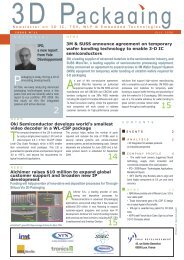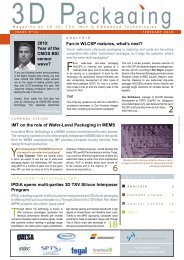September 2011 - I-Micronews
September 2011 - I-Micronews
September 2011 - I-Micronews
Create successful ePaper yourself
Turn your PDF publications into a flip-book with our unique Google optimized e-Paper software.
S E P T E M B E R 2 0 1 1 I S S U E N ° 1 3<br />
INDUSTRY REVIEW<br />
Maturing HCPV supply chain looks<br />
to volume production issues<br />
Once the HCPV industry starts shipping hundreds of megawatts, its supply chain will<br />
have to transition to volume production as well. And a high volume business can’t be<br />
built all on custom components and custom assembly equipment.<br />
step is to work with assembly companies to design<br />
efficient production processes for these components.<br />
Then HCPV makers won’t have to do the iterations of<br />
the optics design themselves, but they can choose<br />
the appropriate balance of performance vs cost, and<br />
the tooling will already be there. “Customers can<br />
then buy components off the shelf, like in a mature<br />
industry,” says Leutz, noting that some users might<br />
for example prefer the lighter weight of PMMA, while<br />
others installing in areas with frequent sandstorms<br />
may prefer more scratch-resistant glass.<br />
Concentrator Optics<br />
Fresnel Lens Parquet<br />
(Courtesy of Concentrator Optics)<br />
“Performance<br />
data that we can<br />
talk about<br />
will help the<br />
bankability of the<br />
whole sector,”<br />
explains Ralf Leutz,<br />
Concentrator Optics.<br />
10<br />
Some helpful steps would be openly available<br />
data on the performance of some HCPV optics<br />
components, coordinated optimization of<br />
the design of the primary and secondary optics to<br />
work together, and coordinated optimization with<br />
manufacturing technologists to design efficient volume<br />
production. So Concentrator Optics founder and GM<br />
Ralf Leutz cooked up a plan to work with secondary<br />
optics supplier Isuzu Glass and cell and receiver maker<br />
AZUR SPACE to make test mockup HCPV modules<br />
to compare various combinations of three different<br />
Fresnel lenses, two different secondary optics and two<br />
different multijunction cells, to get module performance<br />
data that could be released publicly. “With tighter<br />
tolerance budgets, the design of the primary and<br />
secondary optics have to be optimized together with<br />
multiple iterations, but when we make these products<br />
for customers we can’t share how results compare to<br />
other designs or materials,” says Leutz. “Performance<br />
data that we can talk about will help the bankability of<br />
the whole sector.” Aiming for quick results, the three<br />
companies each simply supplied their components for<br />
the mockup modules for testing.<br />
Early results are showing relatively small differences<br />
between PMMA and silicone-on-glass (SOG) Fresnel<br />
lenses, and are quantifying the difference between the<br />
relatively higher performance kaleidoscope secondary<br />
optics and the lower cost half-egg alternatives. With<br />
the data on the optimized optical designs, next<br />
“We’ve played with the process long enough,” asserts<br />
Leutz. “There will have to be some standardization.”<br />
He argues that though leading companies will<br />
continue to distinguish themselves with their<br />
particular technologies, much of the industry will<br />
go to a mainstream volume production option using<br />
Fresnel lenses, secondary optics and triple junction<br />
cells. “Once the HCPV industry gets to a few hundred<br />
megawatts, it will start to look a lot more like the<br />
flat panel PV market,” suggests Leutz. “The key issues<br />
will move beyond technology, to the financing, the<br />
marketing, and the big companies. We have to be<br />
prepared for that.”<br />
While a second tier of upstart HCPV players might<br />
economically ramp production of these more standard<br />
systems, currently all the leading HCPV systems<br />
makers choose quite different options to optimize<br />
their systems. Soitec uses SOG Fresnel lenses but<br />
skips the secondary optic for easier and cheaper<br />
manufacturing, and instead compensates with extra<br />
accuracy in its trackers. Amonix uses lighter acrylic<br />
Fresnel lenses for its large units, but with a low cost,<br />
reflective aluminum secondary optic. SolFocus uses<br />
mirrors for both the primary and secondary optics,<br />
but does use a rod-shaped refractive third optic to<br />
gain a particularly large acceptance angle to allow<br />
more tolerance for imprecision in assembly and<br />
installation.<br />
Isuzu Glass: Design for manufacturing,<br />
optimization with primary, may reduce<br />
secondary optics cost<br />
Systems makers have had to design their solutions<br />
without fully knowing manufacturing costs for their<br />
custom designed components. Molded glass optics<br />
specialist Isuzu Glass reports that many HCPV<br />
companies have come to it with their designs for
















